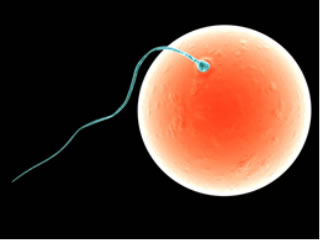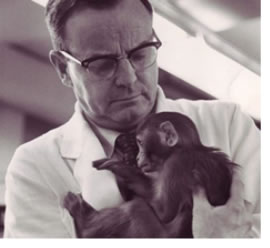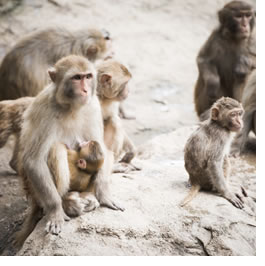Prenatal
Development begins long before an infant is born. Expectant mothers can feel strong movement and kicking -even hiccupping - inside them during the later stages of pregnancy.
We can also "see" a fetus, which is an unborn infant, sucking their thumb, thanks to new ultra sound techniques.

Prenatal development begins with conception or the union of sperm and egg. The result is a fertilized egg called a zygote and it contains the genotype or the genetic composition of the future person.
 A sperm implanting an egg
A sperm implanting an egg
The zygote is now called an embryo and is only about 1.5 inches long. After the eighth week the fetal stage begins and the embryo is now called a fetus. At 6 months the fetus can cry, open and close it's eyes and make a fist. The stage lasts until birth.
Teratogens
The mother's womb is a very secure place for development to take place but there are agents called teratogens, which are chemicals and viruses that can reach the developing child and cause harm.
One of the most talked about teratogens is alcohol. Its use during pregnancy can result in children that have fetal alcohol syndrome. Alcohol is harmful anytime during the prenatal development and it results in growth retardation, cognitive deficits, and facial deformities.
Types of Terratogens:
Cigarettes
- Possible Problem: Premature birth, Lung problems
- Critical Time: After 20 Weeks
Lead
- Possible Problem: Anemia, Mental retardation
- Critical Time: Throughout pregnancy
Rubella (German Measles)
- Possible Problem: Mental retardation, possible death
- Critical Time: First months
Aspirin
- Possible Problem: Bleeding problems
- Critical Time: Last month and at birth
Cocaine
- Possible Problems: Spontaneous abortion, neurological problems
- Critical Time: Throughout pregnancy
Infancy
Infancy begins with birth and lasts until about two years of age.
There are dramatic changes in the child during this stage. In physical development, height and weight are increasing faster than at any other point in time.
The normal birth weight and height is 5.5 - 10 pounds and 14-20 inches. Most infants double their birth weight by the fifth month and triple it by the end of their first year.
They grow about 10 inches in the first year. During the second year, this growth continues but the pace slows.
Babies are born with reflexes that serve as survival skills. A few of them are the Palmer reflex; it is also called the grasping reflex.
The Moro reflex will have the child throw his arms and legs out and then bring them back into a fetal
position when startled.
The rooting reflex results in a child
turning its head toward a gentle
stimulus applied to the corner of the
mouth or cheek and then start sucking.
Most of these reflexes disappear over the first year. Why?
Senses
As far as their senses, infant's visual abilities are not very developed. In fact at birth, babies are legally blind.
Two-month olds preferred to look at human faces rather than anything else.
They also prefer to look at faces that resemble real faces and not jumbled up ones. Infants have been shown to develop depth perception by the time they crawl.
Hearing is much better developed at birth. Newborns will stop and turn their heads when they hear unusual sounds.
They prefer high-pitched sounds to low and they are soothed by soft voices and singing. They also respond to strong odors and wrinkle their noses. They will smile and show a licking motion to sweet smells.
Babies also prefer sweet-tasting liquids and will not suck salty or bitter liquids.
Motor Development
This offers approximate ages for motor development.
Age in Months: Motor Skills
1-3: can lift head and sit with support
4-8: Sits without support for brief periods, holds head still looks around
8-12: Coordinated hand activities, controls trunk and sits without support, walking with help
14: Standing and walking alone without assistance
18: Running
Social Development
A psychologist named Harry Harlow worked with baby monkeys to find out what was the most important thing babies needed for healthy development.
He was a professor at the University of Wisconsin-Madison and chose to work with rhesus monkeys because they are genetically similar to us.
 Image Citation: University of Minnesota. (n.d.). Harry Harlow's loving monkeys. Available at: http://blog.lib.umn.edu/hutch213/myblog/2012/03/harry-harlows-loving-monkeys.html
Image Citation: University of Minnesota. (n.d.). Harry Harlow's loving monkeys. Available at: http://blog.lib.umn.edu/hutch213/myblog/2012/03/harry-harlows-loving-monkeys.html

Harry Harlow became interested in his work because of a condition called the Marasmus syndrome that existed in orphanages. The symptoms of this condition were apathy, withdrawal and a high death rate.
Harlow wanted to see what was missing from these children. He could not work with human babies so he chose a close genetic substitute, the rhesus monkey. He set up three conditions, baby monkeys with monkey mothers, surrogate wire mothers with baby monkeys and surrogate soft wire mothers with monkey babies.
The results of his research demonstrated the importance of contact comfort which is the soft touch and feel of another object.
Harlow's work was extended by a psychologist named Mary Ainsworth. She studied infants around the world and found out that at first they just want to be held, by anyone. By four months children form specific attachments to their main caregivers. Ainsworth talked about two types of attachment.
Secure attachment means that the infant seeks proximity, contact, and interaction with the caregiver after separation. Insecure attachment means that the infant cannot be calmed or ignores the caregiver after separation.
Cognitive Development
Language development beings with crying, cooing and babbling but these are not considered true language since they do not use symbols with specific meanings.
These sounds, though, are the beginnings of verbalization. Here is the sequence of language development:
1. Cooing (vowel-like sounds ooh and aah - during the 2nd month)
2. Babbling (sounds of speech da, ba, ma - which do not hold any meaning, begins in 4th month)
3. One Word Stage (1 year-usually nouns...doggie, mama ,baba)
4. Two word Telegraphic speech ( 2 years...want milk, me go, no ball)
Cooing and babbling are universal and it is not until the one and two word stages that unique vocal patterns and accents emerge.
Language contains three basic elements:
phonemes which are the sounds,
morphemes which are the basic units
of meaning and syntax which is the
grammar of language.
We will cover language development more fully later.
A psychologist named Noam Chomsky put together the language acquisition theory.
This theory states that we are born with the ability to speak. Our brains are hardwired for speech and we need to observe and imitate speech to acquire it correctly.
Here again we see the nature/nurture idea. We are born with the ability to speak
(nature) but we need the environment to teach us the way to speak (nurture).
 Image Citation: Duncan Rawlinson. (2004.). Noam Chomsky. Available at: http://commons.wikimedia.org/wiki/File:Noam_Chomsky_2004_flickr.jpg
Image Citation: Duncan Rawlinson. (2004.). Noam Chomsky. Available at: http://commons.wikimedia.org/wiki/File:Noam_Chomsky_2004_flickr.jpg